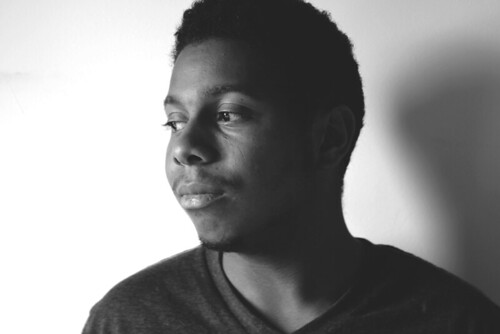Richie Pope is another artist participating in our SMART show, and one of our most frequent contributors. His work has been in six of our previous shows: Pokemon Battle Royale, Tarot, Mystics, and the Occult, Girls: Fact + Fiction, Macro + Micro, Beautiful Forever, and Night of the Exquisite Corpse. He will also be showing in our upcoming sci-fi show, Station Zero, and our RPG self-portrait show, Role Models. Needless to say, we are very big fans of his work.
Where are you from, and where do you currently live?
I'm originally from Newport News, VA, but I've been living in Richmond for 9 years now.
How would you describe your art?
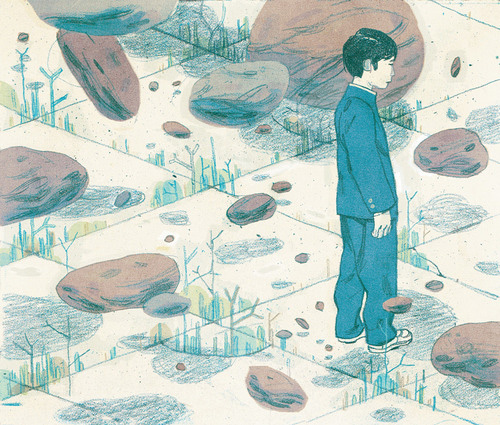
Over Nine Thousand by Richie Pope
Featured in Macro + Micro Exhibition
How do you spend your time when you’re not making art?
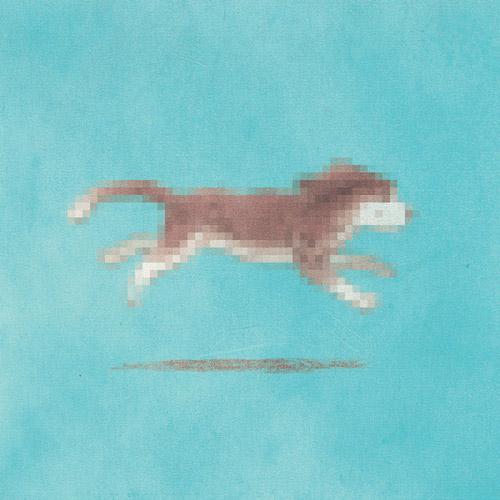
Goodbye, Max by Richie Pope
Featured in Smart Exhibition
Thank you for the wonderful interview, Richie!
You can see more of Richie's work and process on his website here
And you can purchase the three piece print Goodbye, Max here
Where are you from, and where do you currently live?
I'm originally from Newport News, VA, but I've been living in Richmond for 9 years now.
How would you describe your art?
My work combines my
sketchbook observational drawings with more imaginative concepts, resulting
in very dreamlike images.
Many of your illustrations
are surreal. Where do your ideas come from?
My ideas really just float around in my head until I can reach up and grab hold of one. Fireflies is based off a childhood memory of catching fireflies with my older sister outside our family's apartment. I depicted the kid (myself) as a cartoon character. With Adapting to Extreme Conditions, I wanted to play with the idea of someone being out of place, yet finding a way to exist. The result was a man in a deep-sea diver suit waiting for the bus in an underwater neighborhood. How Cats Find Their Way Home is about the mystery of how lost cats return to their owners from as far as hundreds of miles away. I imagined that cats might have some sort of inner compass. I also made a visual connection between the shape of a cat's eye and the shape of a compass, so that became the driving idea.
My ideas really just float around in my head until I can reach up and grab hold of one. Fireflies is based off a childhood memory of catching fireflies with my older sister outside our family's apartment. I depicted the kid (myself) as a cartoon character. With Adapting to Extreme Conditions, I wanted to play with the idea of someone being out of place, yet finding a way to exist. The result was a man in a deep-sea diver suit waiting for the bus in an underwater neighborhood. How Cats Find Their Way Home is about the mystery of how lost cats return to their owners from as far as hundreds of miles away. I imagined that cats might have some sort of inner compass. I also made a visual connection between the shape of a cat's eye and the shape of a compass, so that became the driving idea.

Over Nine Thousand by Richie Pope
Featured in Macro + Micro Exhibition
How long does it take you to make an illustration?
Depending on how complex it is, anywhere from 2 to 15 hours. I usually start and finish in one or two sittings.
What materials/processes do you typically use?
My illustrations usually start with a quick and loose graphite drawing. I like to use 2B-4B pencils because of their value range. Carpenter pencils are pretty much made of magic. I sharpen them with a knife to get really irregular tips for a wider range of line width. I just started getting into gouache a couple of months ago. I paint on top of the drawing or on another sheet of paper that I scan in separately. Once I scan in everything, I just start collaging. The final becomes a mix of final drawing, drawings on different layers, stock textures that I made, scribbles and other things. In general, I know where the illustration is going, but there's a good chunk of spontaneity involved as well.
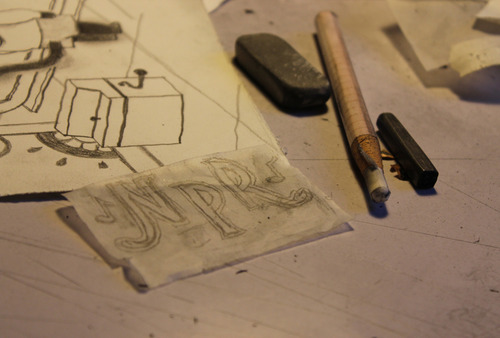
My illustrations usually start with a quick and loose graphite drawing. I like to use 2B-4B pencils because of their value range. Carpenter pencils are pretty much made of magic. I sharpen them with a knife to get really irregular tips for a wider range of line width. I just started getting into gouache a couple of months ago. I paint on top of the drawing or on another sheet of paper that I scan in separately. Once I scan in everything, I just start collaging. The final becomes a mix of final drawing, drawings on different layers, stock textures that I made, scribbles and other things. In general, I know where the illustration is going, but there's a good chunk of spontaneity involved as well.

As one of the artists in our upcoming SMART show, how are you interpreting the title?
I want to communicate an idea, but how do I do it without spelling it out for the viewer? This question is what drives my illustration work, so I took the same approach with my piece 'Goodbye, Max' for the SMART show.
I want to communicate an idea, but how do I do it without spelling it out for the viewer? This question is what drives my illustration work, so I took the same approach with my piece 'Goodbye, Max' for the SMART show.
Is there a trend in
art/culture that is particularly interesting you right now? If
so, is it influencing the work you create?
It's really interesting to see my generation
of illustrators and how big a role the internet is playing. It's easy to
dismiss the number of ‘likes’ and ‘re-blogs’ as lacking any true value, but all
of the recent opportunities that have come my way were because something I drew
blew up on Tumblr, Facebook, or other social media. The internet is free
promotion if your work is strong enough and seen by the right people.
What are your main sources of inspiration?
Memories and dreams are a huge inspiration for my work. I like people and situations that are familiar but not quite 'right'. That ambiguity is really interesting to me. Anime (and manga), film, comics and video games find their way into my work. Street art is really beautiful to me as well. It's often so loose and full of energy, like giant sketchbook pages. I'm also a sucker for the composition kings of 60's and 70's illustration.
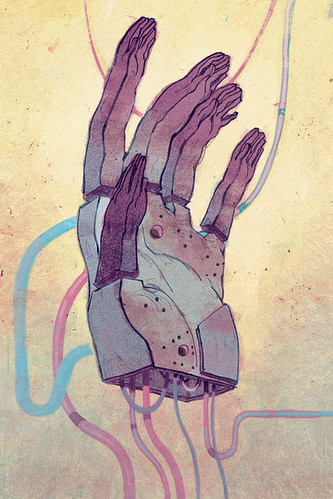
The First Bionic Hand That Can Feel by Richie Pope
Memories and dreams are a huge inspiration for my work. I like people and situations that are familiar but not quite 'right'. That ambiguity is really interesting to me. Anime (and manga), film, comics and video games find their way into my work. Street art is really beautiful to me as well. It's often so loose and full of energy, like giant sketchbook pages. I'm also a sucker for the composition kings of 60's and 70's illustration.

The First Bionic Hand That Can Feel by Richie Pope
How do you spend your time when you’re not making art?
I like to
make music, mostly EDM/hip-hop stuff. I'm a gamer for life, so video games are
a nice interactive way to escape. I also practice scales on the harmonica. I
can't play any songs (yet).
Your lady, Nicole Hamilton, is also an artist. How would you describe her work in comparison to yours? Do you collaborate often?
Nicole's animation and illustration work is really energetic and loose, which plays nicely with her clean line work and coloring techniques. I draw just as fast, but my line work is more raw and imperfect. We sometimes collaborate on some exquisite corpse drawings. We had a blog with some of these drawings and actually thought about re-vamping it recently. There was the quintessential Adventure Time fan art that we worked on together. Nicole did the line work, and I did the coloring. It turned out really creepy, bizarre, and beautiful. Our collaborations really just evolve into their own weird amalgamations of both our voices. Nicole draws a lot from her own imagination, which I had neglected in school in favor of a heavy reliance on reference. Her work has definitely influenced me to trust my own imagination more, and it's given me more confidence in my work. In other words, she's pretty swell.
What are your artistic and career ambitions?
I want to build my illustration work and brand to the
point where I can work on my own intellectual property, whether that be
animations, comic work, street art, fine art or whatever. I want
people to believe in the world that I'm building. I look to people like
Mike Mignola, KAWS, Murakami, Aryz. People have complete faith in them as
creatives and that's pretty amazing. It's a lofty goal, but I wouldn't mind
being up there in that same league of creative freedom.
What other artists should Light Grey and our blog followers check out?
Leslie
Herman, Cathryn Hutton, Jeffrey Alan Love, Eric Pfeiffer, Dadu Shin, Julia
Scott, Allison Smith, Chris Visions. They're all really talented, original and good people.
We have an upcoming show about inspiration posters? Do you have any inspirational words of wisdom you'd care to share?
Take the advice that helps you. Throw out the advice that doesn't. This is how you'll carve your own lane.
Take the advice that helps you. Throw out the advice that doesn't. This is how you'll carve your own lane.

Goodbye, Max by Richie Pope
Featured in Smart Exhibition
Thank you for the wonderful interview, Richie!
You can see more of Richie's work and process on his website here
And you can purchase the three piece print Goodbye, Max here

